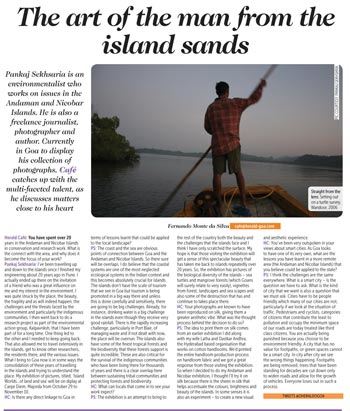
The art of the man from the island sands

Pankaj Sekharia is an environmentalist who works on issues in the Andaman and Nicobar Islands. He is also a freelance journalist, photographer and author. Currently in Goa to display his collection of photographs, cafe catches up with the multi-faceted talented, as he discusses matters close to his heart.
Q: You have spent over 20 years in the Andaman & Nicobar Islands in conservation and research work. What is the connect with the area, and why does it become the focus of your work?
A: I've been travelling up and down to the islands since I finished my engineering about 20 years ago in Pune. I actually ended up there on the invitation of a friend who was a great influence on me and my interest in the environment. I was quite struck by the place, the beauty, the fragility and as will indeed happen, the challenges and the threats faced by the environment and particularly the indigenous communities. I then went back to do a research project as part of the environmental action group, Kalpavriksh, that I have been part of for a long time. One thing led to the other and I needed to keep going back. That also allowed me to travel extensively in the islands, get to know other researches, the residents there, and the various issues. What I bring to Goa now is in some ways the consolidation of these years of travelling in the islands and trying to understand the place. My exhibition of pictures, titled, 'Island Worlds... of land and sea' will be on display at Carpe Diem, Majorda from October 29 to November 10.
Q: Is there any direct linkage to Goa terms of lessons learnt that could be applied to the local landscape?
A: The coast and the sea are obvious points of connection between Goa and the Andaman and Nicobar Islands. So there sure will be overlaps. I do believe that the costal systems are one of the most neglected ecological systems in the Indian context and this becomes absolutely crucial for islands. The Islands don’t have the scale of tourism that we see in Goa but tourism is being promoted in a big way there and unless this is done carefully and sensitively, there are going to be big challenges. Already, for instance, drinking water is a big challenge in the islands even though they receive very good rainfall. There is the rapidly increasing challenge, particularly in Port Blair, of managing waste and if not dealt with now, the place will be overrun. The islands also have some of the finest tropical forests and the biodiversity that these forests support is quite incredible. These are also critical for the survival of the indigenous communities who have been living there for thousands of years and there is a clear overlap here between sustaining tribal communities and protecting forests and biodiversity.
Q: What can locals that come in to see your work expect?
A: The exhibition is an attempt to bring to the rest of the country both the beauty and the challenges that the islands face and I think I have only scratched the surface. My hope is that those visiting the exhibition will get a sense of this spectacular beauty that has taken me back to islands repeatedly over 20 years. So, the exhibition has pictures of the biological diversity of the islands - Sea turtles and mangrove forests (which Goans will surely relate to very easily), Vignettes from forest, landscapes and sea scapes and also some of the destruction that has and continue to takes place there.
Q: Your photographs are known to have been reproduced on silk, giving them a greater aesthetic vibe. What was the thought process behind the decision to do so?
A: The idea to print them on silk comes from an earlier exhibition I did along with my wife Latha and Dastkar Andhra, the Hyderabad based organisation that works on cotton handloom. We’d printed the entire handloom production process on handloom fabric and we got a great response from those visiting the exhibition. So when I decided to do my Andaman and Nicobar exhibition, I thought I’ll try it on silk because there is the sheen in silk that helps accentuate the colours, brightness and beauty of the islands. In some sense it is also an experiment – to create a new visual and aesthetic experience.
Q: You’ve been very outspoken in your views about smart cities. As Goa looks to have one of its very own, what are the lessons you have learnt in a more remote are (the Andaman and Nicobar Islands) that you believe could be applied to the state?
A: I think the challenges are the same everywhere. What is smart city – is the question we have to ask. What is the kind of city that we want is also a question that we must ask. Cities have to be people friendly which many of our cities are not, particularly if we look at the situation of traffic. Pedestrians and cyclists, categories of citizens that contribute the least to pollution and occupy the minimum space of our roads are today treated like third class citizens. You are actually being punished because you choose to be environment friendly. A city that has no value for footpaths, or green spaces cannot be a smart city. In city after city we see the wrong things happening. Footpaths are being removed, trees that have been standing for decades are cut down only to widen roads and allow for the growth of vehicles. Everyone loses out in such a process.





